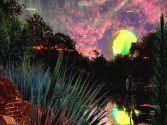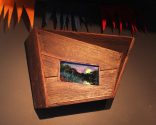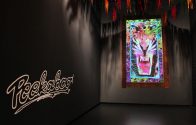by Reggie Michael Rodrigue, louisianaesthetic.com
What do you get when you cross the jungle imagery of famed 19th century painter Henri Rousseau, the Vietnam War, Louisiana swamps, 1980′s aesthetics, maybe a little of the 18th century poet William Blake’s “The Tiger,” new age mysticism, quantum mechanics and 21st century digital video techniques? You get artist Dave Greber’s video installation “Peekaboo,” which is currently running at Arthur Roger Gallery.
Greber’s installation inhabits a tightly edited space. The walls are painted jet black. The exhibition title is painted in a font similar to the blammoriffic ones that are meant to accentuate onomatopoeia in comic books. Greber has a fondness for flags, and in this case, he strings them from the ceiling. They echo the exotic foliage present in Greber’s videos, which are housed in irregular wooden frames. Together the flags and videos add a sultry flavor to the minimal surroundings.
In the videos, Greber presents his own twisted version of the imagery of the French painter Henri Rousseau. “Le Douanier,” as he was called (a derogatory nickname given to him because he actually was a customs toll collector as well as a “naive” artist), painted some of the most fantastical paintings of the post-Impressionist/early Modernist period. In Rousseau’s best works, we are transported to lush, tropical jungles, resplendent with exotic foliage and flowers. Incongruous odalisques luxuriate on chaise lounges, and tigers prowl and pounce on their prey. However, these hyper-images of abundance are delivered in a flat style that belied that fact that Rousseau was untrained. Rousseau’s naive style was ridiculed by many until such canonical Modern masters as Picasso, Matisse, the Delaunays, as well as the Surrealists, recognized his genius. Considering Greber’s penchant for over-abundance, flatness and exoticism in his own work, it easy to see why he is also attracted to Rousseau’s paintings.
Greber has stated that he chose to address Rousseau’s jungle paintings in an attempt to strike out in a new direction. In the past, Greber has focused on imagery and techniques used in commercials and contemporary media to fuel his video satires. With “Peekaboo,” Greber moves away from satire, to address history (the “garden” variety and the “art” variety), Imagist poetics, the intersection of nature and technology, and what Greber terms as “the manner in which metaphysical beings manifest and interact within our dimension.” This idea of “manifestation” ties in with the hallucinatory figures that pop-up in Rousseau’s paintings, and it also supplies the subtext for Greber’s exhibition. The title “Peekaboo” comes from the children’s game that plays on a baby’s inability to master the concept of object permanence. In Greber’s videos, animals and people “manifest.” Yet, they also disappear into thin air or are obscured by elements in the visual space in front of them.
In “Peekaboo Tiger, ” the largest video in the installation, the face of a roaring tiger is obscured by a swarm of dots, surging electrical currents , flames and breezy palm fronds. It looks as if it is the lost lovechild of a Def Leppard album cover and the throne scenes from “The Wizard of Oz.” I also, couldn’t help but think of the Romantic poet William Blake’s “The Tiger” when viewing it. “Peekaboo Tiger” is definitely “burning in the night” and displays a “fearful symmetry.” The dots that meander across the tiger’s face also called to mind subatomic particles.
The smaller videos in “Peekaboo” depict two hyper-landscapes and a man peeking out from behind a thicket of jungle foliage. The landscapes are beautiful, surreal and oddly meditative with flocks of birds passing through, disappearing and reappearing inside certain aspects of the landscape such as a full moon or a body of water. The water reflects the sky, but the sky strangely reflects the water as well. Occasionally, a mysterious explosion sets off in the distance. These occurrences resemble the footage of jungles erupting into flames during the Vietnam War. Strange, gassy, balls of light appear, hover and disappear over Greber’s landscapes as well. In Louisiana, the gaseous balls of light that appear in the swamp at night are known as “feufollets.” Local folklore has it that these luminous balls of gas are actually the departed souls of people who lost their lives in the swamps. They are said to lead foolish interlopers to their own watery graves. Within “Peekaboo – Small Window,” a man stands silently in the water observing the phantasmic wonder of it all.
And wonderous it is! Greber has concocted a Romantic mental/digital landscape in “Peekaboo” that, despite all of my efforts, really defies explanation. It is pure and sublime visual/aural poetry that incorporates elements across time and across genres into a formidable yet succinct installation. It transports viewers to a world that is pregnant with infinite possibility and awe for nature. “Peekaboo” is also a celebration of our own technological prowess as a civilization moving through history in a universe which operates beyond the illusion of time and dichotomy. In the end which is the beginning which is the end, we and our technology are just as much a part of nature as the tiger “burning in the night.” I think Greber would agree: we all manifest from the same source.










